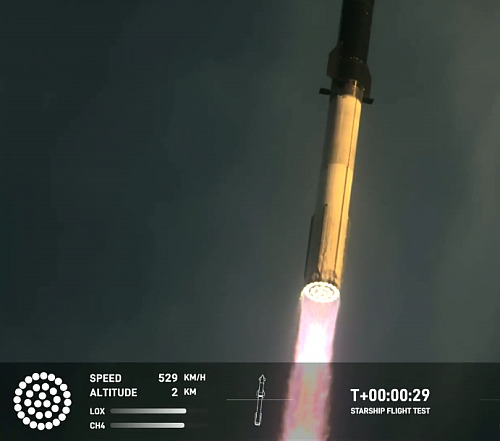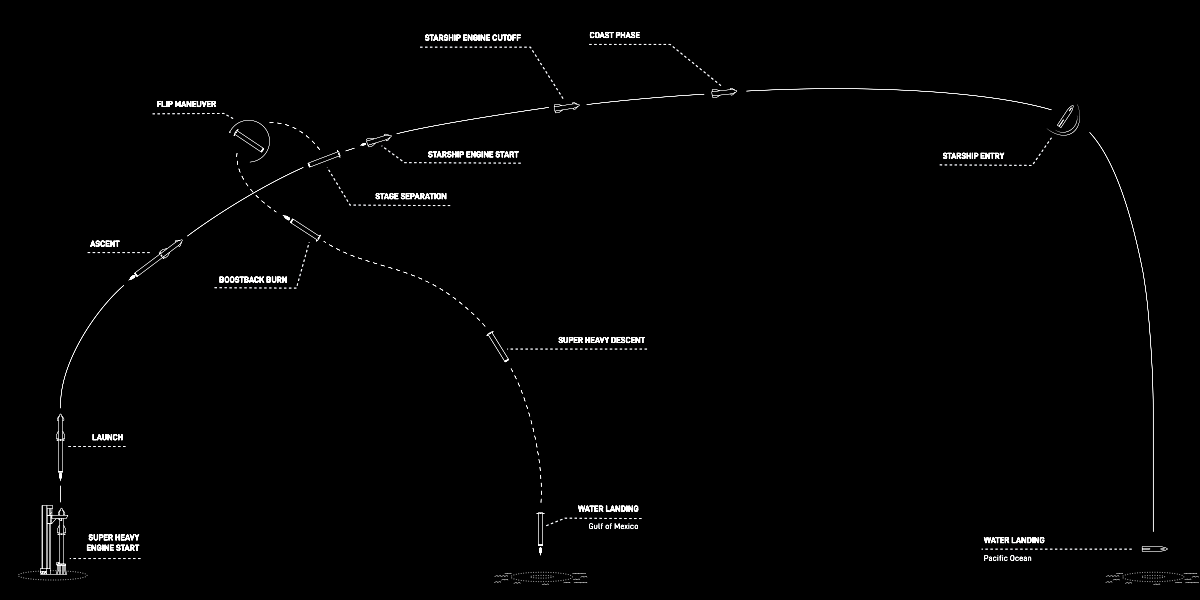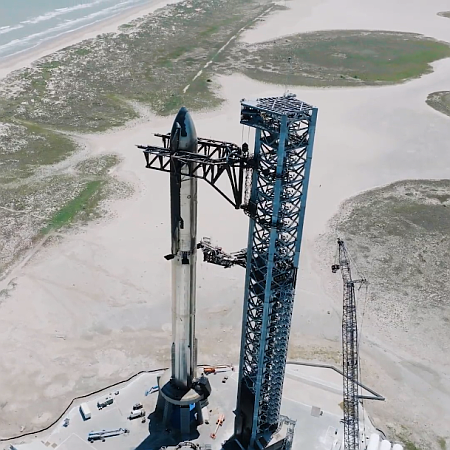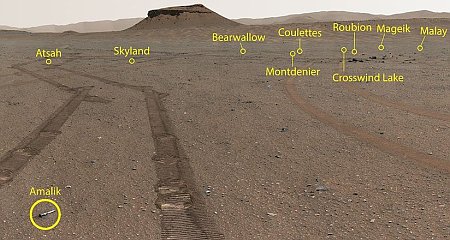Erik Wernquist – One revolution per minute
An evening pause: A short film that attempts to visualize what it would really be like to be on a rotating interplanetary spaceship, with artificial gravity. Quite mesmerizing.
Hat tip Rex Ridenoure.
An evening pause: A short film that attempts to visualize what it would really be like to be on a rotating interplanetary spaceship, with artificial gravity. Quite mesmerizing.
Hat tip Rex Ridenoure.
An evening pause: This movie used to be a tradition for television on Thanksgiving. At that time the holiday was well linked with the then joyous and relatively Christian Macy’s Day Parade (now warped into a queer agenda demonstration).
I think it makes for a good opening to the holiday season.
An evening pause: I am pretty sure this is in Polish. The music however swings from Eastern European folk to American blues.
Hat tip Judd Clark.
Less than two weeks after SpaceX obtained regulatory approval to offer its Starlink system in India, Eutelsat-OneWeb (newly merged) has now gotten its own approval.
Eutelsat-OneWeb is half owned by an Indian investment firm, so it is no surprise it obtained this approval soon after SpaceX. The two companies will now be competing aggressively for business in this giant country, whose technological capabilities has been renewed in recent years by the abandonment of a socialist/communist government for a leadership focused on encouraging freedom, capitalism, and competition.
SpaceX early last night continued its campaign to reach 100 launches in 2023, its Falcon 9 rocket launching for the third time in just over four days, lifting off from Cape Canaveral carrying 23 more Starlink satellites into orbit.
The first stage completed its fifteenth launch, landing on a drone ship in the Atlantic.
The leaders in the 2023 launch race:
86 SpaceX
52 China
14 Russia
7 Rocket Lab
7 India
American private enterprise now leads China 98 to 52 in successful launches, and the entire world combined 98 to 81. SpaceX by itself is now leads the rest of the world (excluding American companies) 86 to 81.
With this launch, the number of successful orbital launches in 2023 now matches the record total of 179 set last year. With a little more than five weeks to go, expect that number to top 200 before the year is out, especially because China has historically tended to launch a lot of rockets in December.
The high altitude balloon company World View has ended its negotiations, begun early this year, with a venture capital investment firm to merge and make its stock public.
In a Nov. 17 statement, World View and Leo Holdings Corp II announced they were canceling plans announced in January to merge. The decision to end the merger was mutual, the companies said.
The companies did not give a specific reason for calling off the deal. “Over the course of 2023, World View received strong interest from potential investors,” the companies stated. “However, given challenging market conditions, World View and Leo jointly determined that it was the best course of action at this time to not proceed with their previously announced transaction.”
There could be a lot of good and bad reasons this deal fell through. Mostly likely World View officials saw the generally negative consequences experienced by other space startups that went public in this manner in the past few years, and decided it better to hold off.
Recognizing a desperate need of the military to ramp up production of solid rocket motors after much of its missile stockpile has been depleted by President Biden’s large gifts to the Ukraine, the rocket engine startup Ursa Major has now announced it is entering solid-rocket motor business.
Describing the solid rocket motor [SRM] market as “plagued by a broken supply chain and an overextended industrial base,” the Colorado startup today announced its plans to use its 3D printing techniques developed for liquid rocket engines to speed production of solid-fuel propulsion systems. Ursa Major has received several contracts from the Air Force Research Laboratory for its work on a new rocket engine for heavy space launch vehicles, as well as a hypersonic engine.
“Traditional SRM providers rely on production lines that are difficult to re-tool, expensive to ramp up, and dependent on a significant workforce to operate,” the company said in a press release touting its “new approach” to manufacturing, dubbed Lynx. “Ursa Major is offering a new way to scale production of SRMs,” Ursa Major CEO Joe Laurienti said in the press release. “Lynx meets the defense industry’s need for a faster, cheaper, scalable, and flexible SRM production process that results in better-performing solid rocket motors.”
The article also notes that at present the military is dependent on only two companies for new solid rockets, Northrop Grumman and Aerojet Rocketdyne (now L3Harris). The article also notes that it could take anywhere from five to eighteen years for these companies to replenish the depleted stocks.
The bottleneck however has brought several new players into the field, with the military eager to issue contracts to these new players. This decision by Ursa Major is thus a very good one.

Superheavy & Starship, shortly after liftoff on November 18th
In a tweet on November 19, 2023, Elon Musk revealed that SpaceX could be ready for its next Starship/Superheavy test launch in only a matter of weeks, assuming federal red tape doesn’t get in the way.
Starship Flight 3 hardware should be ready to fly in 3 to 4 weeks. There are three ships in final production in the high bay (as can be seen from the highway).
In reporting on the second test launch on November 18, 2023, I noted that with prototypes ready to go SpaceX could probably launch within a month. Musk has now confirmed that assessment.
I also predicted that the FAA and Fish & Wildlife would not allow such a thing, and though they will determine there is no reason not to launch again, they will not issue a launch licence until the February/April time frame.
I want this prediction clearly on the record. It is important for the public to know the source of these delays.
It is also important for the press to apply pressure on these government paper pushers so they don’t feel encouraged in their intransigence. When I made a similar (and wholly accurate) prediction in May about the second launch, many in the press criticized that prediction (directly and indirectly) for daring to say bad things about government regulators. Now it appears that others in the press are no longer so naive, and are willing to note the slowness of the licensing process.
The regulators might not want to stand in the way and are simply following procedure. The press however mustn’t treat them gently. It must hold their feet to the fire to make sure they don’t take their time doing so.
Moreover, we have seen fewer headlines claiming falsely that the rocket “blew up” or “exploded.” Instead, a large percentage of the press now got it right and noted the mission’s success and that the destruction was not an accident but part of the self-destruct system.
After the last launch I lambasted the press for getting these facts wrong. Maybe holding their feet to the fire forced a reassessment and better reporting this time around.
In a tweet posted only a short time ago, Elon Musk announced that the redesigned and rebuilt Boca Chica launchpad experienced little or no damage during the launch of Superheavy/Starship on November 18, 2023.
Just inspected the Starship launch pad and it is in great condition!
No refurbishment needed to the water-cooled steel plate for next launch.
Congrats to @Spacex team & contractors for engineering & building such a robust system so rapidly!
Musk included the picture to the right in the tweet, showing the essentially undamaged launchpad pad. A close looks suggests there was some damage to the rear pillar near the top, but overall it appears the next launch could occur here very quickly.
Musk of course is wrong about who he credits for redesigning and rebuilding this launchpad. The real credit must go to the FAA bureaucrats who led the investigation and must have clearly guided those SpaceX engineers and contractors. To expect private citizens to think for themselves and come up with such difficult engineering without supervision from government paper-pushers in Washington is unreasonable and unfair. Maybe the Biden Justice Department should consider another lawsuit against Musk, this time for spreading more disinformation!
Moreover, who cares that the launchpad deluge system worked exactly as planned? We must allow Fish & Wildlife to spend several months now to investigate this launch — as well as write a long report of many words — to make sure that deluge of water did not harm any of the wildlife that lives on this barrier island, which has a water table of essentially zero and is flooded regularly and repeatedly by storms over time.
Anyone who disagrees is clearly a bigoted racist who wants to harm little children!
The beat goes on: SpaceX early this morning launched another 22 Starlink satellites, its Falcon 9 rocket lifting off from Vandeberg in California.
The first stage completed its 15th flight, landing successfully on a drone ship in the Pacific.
The leaders in the 2023 launch race:
85 SpaceX
52 China
14 Russia
7 Rocket Lab
7 India
American private enterprise now leads China 97 to 52 in successful launches, and the entire world combined 97 to 81. SpaceX by itself is now leads the rest of the world (excluding American companies) 85 to 81.

Note how all 33 Superheavy engines are firing.
SpaceX this morning successfully launched its Superheavy/Starship heavy lift rocket into its test orbit.
The test flight achieved far more than the first test in April. First, during the entire flight of Superheavy all 33 Raptor-2 engines fired normally. None cut out prematurely. Then at very risky hot fire stage separation — where the second stage (Starship) ignited prior to separation from Superheavy — the correct number of engines shut down, Starship’s engines fired, and Superheavy successfully separated and began its maneuvers for a soft splashdown in the Gulf of Mexico.
At that point mission controllers issued the self-destruct command to destroy Superheavy. Though it appeared that the stage was struggling to flip for its controlled return to Earth, it is also very likely that mission controllers wanted to test that flight termination system after its not perfect performance on the first test flight. Then, the self-destruct command did not activate the instant the command was given, being delayed by about 40 seconds. This time it appeared it worked as planned.
» Read more
While everyone is focused on the Starship/Superheavy launch scheduled for tomorrow at 7 am (Central) at Boca Chica, SpaceX tonight launched another 23 Starlink satellites, its Falcon 9 rocket lifting off from Cape Canaveral.
The first stage successfully completed it eleventh flight, landing on a drone ship in the Atlantic.
The leaders in the 2023 launch race:
84 SpaceX
52 China
14 Russia
7 Rocket Lab
7 India
American private enterprise still leads China 96 to 52 in successful launches, and the entire world combined 96 to 81. SpaceX by itself is now leads the rest of the world (excluding American companies) 84 to 81.

The German rocket startup Isar Aerospace has signed a deal to provide the Andoya spaceport in the north of Norway with a new flight tracking and safety system, to be used by all launches including Isar’s own Spectrum rocket.
The purpose of the autonomous flight tracking system is to precisely and reliably keeping track of the Spectrum launch vehicle’s position, speed and direction of travel as it ascends to orbit, which is important to guarantee Andøya Spaceport’s flight safety requirements. The objective is to further evaluate the use of the system in enabling automated flight termination functionality for launches by Andøya Spaceport’s ground system, autonomously triggering an abort of the mission if ever operational parameters of the launch vehicle are out of bounds.
This announcement today illustrates the rising competition between German rocket startups and European spaceports. Yesterday the Saxavord spaceport in Scotland and another German rocket startup, HyImpulse, announced their own launch deal. Today’s announcement is the response from Andoya and Isar.
Today’s announcement also increases the pressure in the UK’s Civil Aviation Authority (CAA) to get its regulatory act together. Andoya is positioning itself as a good alternative to the two new British spaceports in Scotland, as shown by the red dots on the map above, should red tape in the UK slow launches there.
Because of the sudden announcement by the White House of its own version of a new commercial regulatory space bill, the House Science committee was forced to delay the voting on November 15, 2023 of its own new commercial space bill, put forth by Republicans.
The committee met Nov. 15 to mark up the Commercial Space Act of 2023 and one other bill. At the end of the markup, lasting more than three and a half hours including a recess, the committee’s chairman, Frank Lucas (R-Okla.) said the committee would delay votes to advance both bills until after the Thanksgiving break because of votes on the House floor and “and the nature of additional information that has become available to us.”
The latter comment appeared to be a reference to a legislative proposal released by the White House’s National Space Council less than an hour before the markup regarding a mission authorization concept for new space activities. That proposal would establish a system where both the Commerce Department and the Transportation Department would oversee activities not regulated today, based on the type of activity.
The House bill, introduced Nov. 2 by Lucas and space subcommittee chairman Rep. Brian Babin (R-Texas), would create its own mission authorization system at the Commerce Department. It would also direct Commerce to hand over responsibility for a civil space traffic coordination system to a consortium led by an academic or nonprofit organization, rather than keeping it within the Office of Space Commerce as currently planned. Lucas, in his opening remarks, said he was aware of the new White House proposal but has reservations about it. “These proposals, I fear, simply go in the wrong direction and hurt rather than support America’s space industry,” he said.
Both bills were aimed at realigning the regulatory regime governing private space activities. The House bill’s final form apparently had been written with a lot of industry input. The White House bill, supported by Democrats, appears designed instead to clamp down on commercial space by allowing the federal bureaucracy to regulate everything.
Both bills unfortunately give too much power to the federal government, though the Republican bill at least tries to shift some of that power to the private sector, where it belongs.
One of the main reasons we have had a rennaisance in commercial space in the past decade is that there has been little regulation. The private sector has been left to regulate itself, and it has generally done so very successfully because of the invisible hand of free market forces. Build things right and the world beats a path to your door. Do it badly and no regulation is needed, you go out of business.
Modern Americans no longer trust these fundamentals of freedom and capitalism, and so we have a rush by government to establish “rules,” none of which will really accomplish anything but slow development and innovation and squelch this emerging industry.
Sierra Space yesterday did a major staffing shake up, laying off 165 workers while shifting 150 with secruity clearances from its parent company Sierra Nevada.
Sierra Space this week shipped the first Dream Chaser, named Tenacity, for pre-launch testing at NASA’s Armstrong facility in Ohio. The layoffs began soon after, the Sierra Space spokesperson said, noting the company conducted a surge in hiring this year to complete work on the Tenacity spacecraft.
With Tenacity shipped, Sierra Space’s spokesperson said the company is realigning to focus on the operations phase of Dream Chaser’s first mission, as well as on classified national security work. The latter part of Sierra Space’s realignment includes adding nearly 150 employees with security clearances from Sierra Nevada Corp., the aerospace and defense contractor owned by Fatih and Eren Ozmen, which the space company was spun out of two years ago. Sierra Space’s spokesperson said the company is creating a national security space team to work on several classified contracts.
This shift suggests that at least in the short run, Sierra is putting more focus on future military contracts rather than its civilian manned space projects like its LIFE space module (for the Orbital Reef space station) and future manner versions of its Dream Chaser mini-shuttle. I wonder if the company is having more internal doubts about Orbital Reef and its main partner, Blue Origin. Unlike the stations being built by Axiom and Voyager Space, which have already garnered contracts from both national and international customers, Orbital Reef has not done the same. There could be great doubts in the space community it will be built because of Blue Origin’s absymal record for building anything.
An evening pause: I’m not sure if John Tams is singing, but these are his lyrics used in the British historical television series, Sharpe, set to a traditional British song from the 18th century (hence the line “King George commands and we obey). I like this lyric however:
When Evil stalks upon the land
I’ll neither hold nor stay me hand
But fight to win a better day,
Over the hills and far away.
Hat tip Alton Blevins.
Amazon announced today that its first two Kuiper satellites, launched into orbit by ULA’s Atlas-5 rocket on October 6, 2023, have worked exactly as planned, thus allowing the company to begin building operational satellites.
With the prototypes’ testing in space now complete, Badyal said Amazon plans to begin building the first production Kuiper satellites in December and launch the first satellites for its network in the “latter part of the first half” of 2024. Badyal emphasized that Amazon wasn’t sure what performance to expect from the prototype satellites, since “you don’t know how well it’s going to work in space.”
“They’re working brilliantly,” Badyal said.
The need of Amazon to start launching lots of satellites next year — in order to meet its FCC license requirements to put half of its 3,000+ constellation in orbit by 2026 — puts great pressure on ULA, Blue Origin, and Arianespace to get their new but as yet unlaunchd rockets operating. All three have big launch contracts with Amazon, but none presently appear to have the capability to meet the demands of those contracts.
SpaceX has pushed back the orbital test launch of its Starship/Superheavy rocket one day, to November 18, 2023, because one of the rocket’s grid fins was not working properly during a prelaunch test.
The new launch window opens at 7 am (Central), but is now only twenty minutes long. SpaceX says it will begin its live stream on X and here 35 minutes before liftoff.
The Saxavord spaceport, one of two being built in Scotland, has signed a launch deal from the German rocket startup Hy-Impulse, with two suborbital test launches scheduled for next year and an orbital launch targeting 2025.
HyImpulse, a launch services provider and DLR spinoff based in Baden-Württemberg, Germany, is currently gearing up for its inaugural suborbital launch early next year from Australia. It will however look to conduct two suborbital launches from SaxaVord Spaceport, located in Scotland’s Shetland Islands, from August 2024 onwards. HyImpulse has already secured an Air Navigation Order (ANO) license from the UK’s Civil Aviation Authority for one launch.
These will be followed by first orbital launches from late 2025 onwards. The plan envisions rising to full commercial operations by 2030.
All this assumes that the UK’s Civil Aviation Authority (CAA) can issue the launch licenses in time. After all it only six to ten months to approve those suborbital launches, and almost two years to approve the orbital launch. So far the CAA has proven unable to approve anything within even those long time frames.

The April Starship/Superheavy flight plan. Click for original image.
The slightly revised flight plan for flight two can be found here.

Starship stacked on Superheavy, September 5, 2023,
when Elon Musk said it was ready for launch
UPDATE: The FAA has now issued the launch licence [pdf]. Note it adds that the FAA and Fish & Wildlife have imposed new requirements (as noted in the announcements below) on SpaceX on this and future launches, all of which will have to be reviewed after each launch.
Original post:
————————-
Both the FAA and the Fish & Wildlife department of the Interior Departiment today released their completed investigations of the environmental impacts created by the first test launch of SpaceX’s Starship/Superheavy rocket in April 2023, and (not surprisingly) concluded that the launch did no harm, and that a second launch can be allowed.
The FAA report can be found here [pdf]. The Fish & Wildlife report can be found here [pdf]. Both essentially come to the same conclusion — though in minute detail — that Fish and Wildlife had determined in April 2023, only a week after that first test launch.
No debris was found on lands belonging to the refuge itself, but the agency said debris was spread out over 385 acres belonging to SpaceX and Boca Chica State Park. A fire covering 3.5 acres also started south of the pad on state park land, but the Fish and Wildlife Service didn’t state what caused the fire or how long it burned.
There was no evidence, though, that the launch and debris it created harmed wildlife. “At this time, no dead birds or wildlife have been found on refuge-owned or managed lands,” the agency said. [emphasis mine]
In other words, the investigation for the past seven months was merely to complete the paperwork, in detail, for these obvious conclusions then.
As part of the FAA action today, it also issued range restrictions for a November 17, 2023 test launch at Boca Chica. Though there is no word yet of the issuance of an actual launch license, it appears one will be issued, and SpaceX is prepared for launch that day, with a 2.5 hourlong launch window, opening at 7 am (Central). SpaceX has already announced that its live stream will begin about 30 minutes before launch, at this link as well as on X.
Hat tip to BtB’s stringer Jay and my reader Jestor Naybor for these links.
The Japanese government has created a new $6.6 billion fund that it will provide to its space agency JAXA, spread out over the next ten years, to help develop the country’s commercial space industry.
The very short article at the link provides little additional information. For example, will JAXA be required to act merely as a customer, buying services from competing private companies, or will it be allowed to use this money to create its own projects that it designs, builds, and owns?
The difference is fundamental. Presently JAXA functions like NASA had for decades, partnering with only a handful of big space companies (Mitsubishi for example) to build its own government rockets and spaceships. The results have been comparable to NASA prior to 2010: Little gets built and whatever is built is overbudget and far behind schedule.
Since NASA accepted the idea of capitalism in space, where it no longer builds or owns much but relies on private enterprise to get it done, things have moved fast. Similarly, India and China have followed suit, and both are getting similar good results.
The unanswered question from this story is whether Japan has finally taken the leap to do it as well. Making this transition can be politically difficult, because the space agencies and big space contractors fight to protect their turf. It is not clear if the Japanese government is willing to fight that battle.
If it doesn’t, however, Japan will continue to be a backwater in space, like Russia,as the rest of the world’s space-faring nations increasingly turn to private enterprise, competition, and (most of all) freedom to get results.

According to the company’s CEO, Intuitive Machines is pushing to fly two more Nova-C lunar landing missions next year after its first is launched by SpaceX on January 12th and hopefully lands successfully near the Moon’s south pole on January 19th.
Intuitive Machines is working on two more Nova-C landers for its IM-2 and IM-3 missions, also carrying NASA CLPS payloads. The company has not announced launch dates for those missions, but Altemus said he hoped both could take place by the end of 2024.
“We are planning three missions in 2024,” he said, which will depend in part on NASA’s requirements as well as orbital dynamics. Landings at the south polar region of the moon, the target for IM-2, are linked to “seasons” where lighting conditions are optimal for lander operations. IM-3, he said, would happen “a few months” after IM-2.
Though Nova-C will launch after Astrobotic’s Peregrine lander (launching on ULA’s Vulcan rocket), it will get to the Moon quickly, and will attempt its landing first. If successfully it will therefore be the first private payload to do so.
The company’s ambitions for 2024 are laudable, but depend so entirely on everything going perfectly it will not be surprising if they do not pan out. Nor will it reflect badly on the company if just one mission flies in 2024. Landing a robot on another world is hard. For private companies to do it is harder.
The European Space Agency (ESA) and the American company Voyager Space last week signed an agreement making Voyager’s Starlab space station Europe’s main space station destination, replacing ISS.
Starlab will fulfill that role, at least partially, in the future for the space agencies of individual ESA member states. It’s expected to launch as soon as 2028, with operations set to start in 2029. This will include access for astronaut missions and to conduct research as well as providing opportunities for commercial business development. Starlab is also set to provide a complete “end-to-end” system in low-Earth orbit to which European crews and cargo will journey.
This European deal became more likely when Airbus joined the partnership of Voyager and Lockheed Martin in January 2023. It is also probably why Northrop Grumman in October 2023 abandoned its own space station project and joined this one instead. ESA is a big customer, most likely to guarantee the most profits.
What makes this deal different than ISS is that the station will not be owned by this large government customer. The companies building Starlab — led by Voyager — will be free to sell its services to anyone who wishes to use it. This deal also means that NASA and ESA will be going separate ways after ISS, no longer partnering on a station.
An evening pause: Performed live in Poland, 2015, by the Moniuszko School of Music Symphony Orchestra.
Hat tip Alton Blevins.

Perseverance’s first set of core samples,
placed on the floor of Jezero Crater
Faced with a strong threat of major budget cuts from the Senate, NASA has decided to “pause” the Mars Sample Return mission (MSR) by ramping back some work to consider major changes to the project.
We brought Steve [Thibault] downtown to be the chief engineer in the Headquarters MSR program office … leading a team that consists of all the implementing centers and our European colleagues to stand back and take a look at the architecture with a fresh set of eyes and figure out not only just how to improve our technical margins and make the mission more robust, but also to see if there are ways to implement it in ways to potentially save costs. We’re also going off and listening to industry and seeing what ideas they have.
While the House had approved NASA’s budget request that exceeded $1 billion to complete the mission (more than double its original price tag), the Senate responded by only allocating one quarter of that, demanding NASA come up with a plan that would match its original budget number. This Senate pressure was enhanced by an independent review that harshly criticized the present design of the project, which involves three NASA centers, European participation, and multiple American companies, all building different components that must all interact perfectly.
According to a tweet today by Elon Musk, he has been informed that the federal government will give its blessing for SpaceX to conduct the second Starship/Superheavy test launch from Boca Chica in time for a Friday November 17, 2023 launch.
The launch window opens at 7 am (Central) and lasts until 11:20 am.
Let us all now bow our heads to our lords and saviors at the FAA and Fish and Wildlife for finally deciding to allow this once-free American to simply do something the government was once forbidden from blocking. The worst part is that the fundamental law that forbids such government interference (its called the Constitution and the Bill of Rights) has not been officially repealed, merely morphed into nothing more than fish wrap while everyone decided to look the other way.
Be warned: Even if by some miracle this second test launch goes perfectly, these government agencies are still not going to allow a quick turn-around for a third launch. No, they will put SpaceX through the same investigatory grind, eating up months. And if the more likely scenario occurs, and the launch does not go perfectly, I guarantee the grind will go on longer.
Sovereign power now resides within Washington, not the people of the United States. The proof is how so many of those people now consider this situation normal and expected.